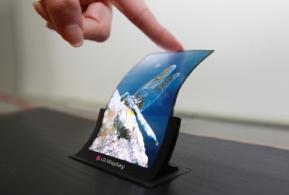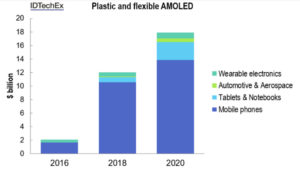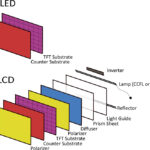Organic Light-Emitting Diode (OLED) displays are made using organic light emitting diodes, which emit light when current runs through them. The basic colors of light for these diodes are Red, Green, and Blue (RGB), which combine to create an extensive range of colors of visible light.

OLED displays are different from Liquid Crystal Displays (LCDs) in that each diode in OLED can be completely turned off which creates a pure black. LCDs require a backlight (usually fluorescent or LED), and the light shows through the LCD to produce a color image on the display screen under the glass. OLED displays are thinner than LCDs. The power savings for OLED is apparent when an OLED phone screen displays an always-on clock on a black background since no power is applied to OLED pixels that display black. Thus, for a smartphone with an OLED screen, a “dark” theme for wallpaper and such is going to save battery life.
Active Matrix Organic Light-Emitting Diode (AMOLED) displays are known for a wide viewing angle, fast response time, and efficient use of power. AMOLED displays are good for devices where power consumption is a priority, such as on smartphones. For instance, the displays in some Apple watches are AMOLED displays, and the iPhone X has an AMOLED screen. AMOLED uses a thin-film transistor (TFT) network and a capacitor for energy storage to drive each pixel separately.
Passive Matrix Organic Light-Emitting Diode (PMOLED) displays drive a row of pixels in the display, rather than individual pixels like AMOLED. PMOLED is cheaper to make than AMOLED, but have a restricted resolution and are not as power efficient as AMOLED, which makes PMOLED a weak candidate for high-resolution smartphone screens. PMOLED screens light up one row of pixels at a time, turning off the line as it moves to light the next row. Thus, if there are 100 lines in a PMOLED display, each line of the display is energized 1/100th of the time. This limits the size of the PMOLED display to a maximum of 5 inches with today’s technology.
Enter the plastic
Manufacturers like Samsung, LG, and Sharp are now substituting plastic substrates for glass substrates, especially on smaller displays. The “active matrix” part of AMOLED is necessary for small form-factor, high-resolution screens, as opposed to a passive matrix, which is not practical for applications like smartphones. Therefore, all smartphones use active matrix technology with their OLED displays. Plastic OLED (pOLED) is an acronym coined by LG for its OLED displays with plastic substrates (which also use an active matrix). Although OLED technologies are similar between manufacturers, performance between displays does differ based on the materials used in all layers of the OLED displays.
Samsung has developed an OLED technology, which they call AMOLED. The trend is to use plastic substrates (rather than glass) because manufacturers can easily form them and plastic allows a phone to flex without breaking. LG’s pOLED is used in LG and some Google Pixel-branded phones. Other devices that use plastic substrates might do so because plastic is both lighter weight, thinner, and easier to mold and shape than glass. Modern wearables have plastic substrates with the added benefit that they are not as easy to break as glass substrates.
Transparent OLED (T-OLED) displays are OLED displays with a see-through substrate. Transparent PMOLEDs, available in small sizes, are becoming common in clocks, although prototypes for T-OLEDs at 55 inches are here.

In the end, the best way to compare screens between similar devices like smartphones and televisions is to look at them, although it’s true that OLED display is going to do more for battery life than an LCD. However, the future of OLED displays is bright. OLED displays of all types are forecasted to reach $57 billion by 2026, according to IDTechEx. Both bendable and curved OLED displays are here, and you can expect to see flexible and foldable OLED displays in the future.


I read your interesting article in search for an answer to my observation:
(AMO)OLED displays are never completely black – even if a fully black image (RGB 0,0,0) is displayed.
I tested this with Samsung phones (AMOLED) and with a Toshiba OLED tablet.
In a fully dark room it is evident, that even a black OLED area (RGB 0,0,0) emits a little light.
Do have an explanation or technology background for this?
Maybe it only applies to active matrix OELD displays?
Are there displays, a black area is actually fully dark?
Thank You,
Ralf
I have a Xiaomi phone with a Samsung made OLED display and black is completely off on my display. My old Samsung Galaxy S7 edge also shows black as completely off and not emitting any light.
I can’t see any reason why a display manufacturer would want to keep pixels turned on when displaying black.